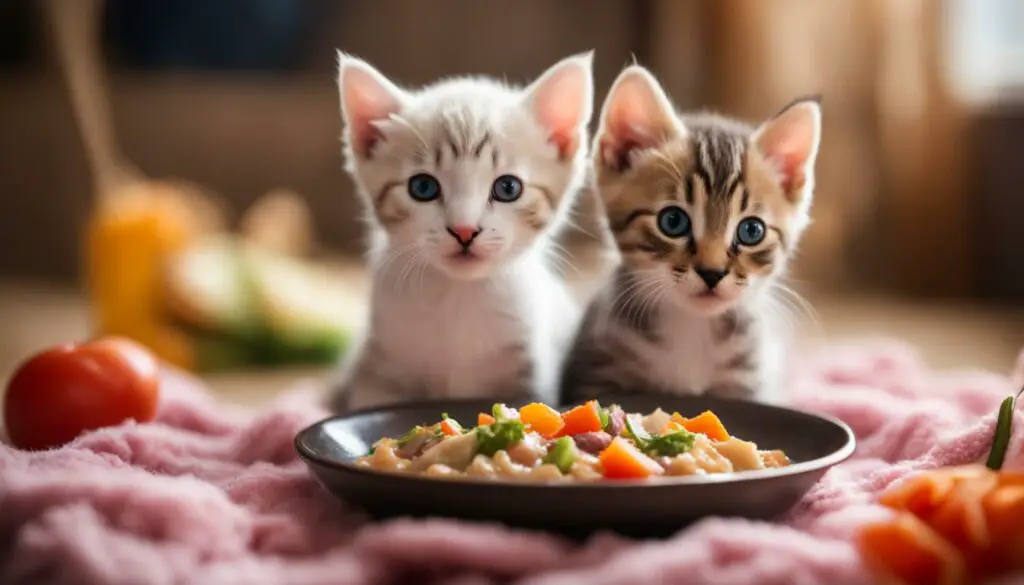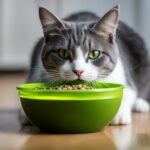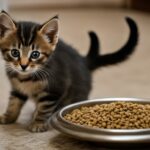As a new cat owner, you may be wondering if it’s safe to feed your 4-week old kittens wet food. The transition from nursing to solid food is an important milestone in their growth and development. In this article, I will provide you with a complete guide on feeding 4-week old kittens wet food, including when to start, the benefits, tips for feeding, and much more.
Key Takeaways:
- 4-week old kittens can start eating wet food as part of their weaning process.
- Wet food has a higher moisture content, which helps keep kittens hydrated.
- Feeding wet food to kittens promotes healthy kidney function and provides the necessary nutrition for their growth.
- Start with a gruel-like texture and gradually reduce the amount of water added to the wet food.
- Consult with a veterinarian for personalized feeding guidelines and to determine the appropriate wet food options for your kittens.
When Can 4 Week Old Kittens Start Eating Wet Food?
Introducing solid food to 4 week old kittens is an important milestone in their development. At around 3-4 weeks old, kittens are ready to start weaning and can begin eating wet food. This transition helps them gradually shift from nursing to consuming solid food, providing them with essential nutrients for growth.
To introduce wet food to 4 week old kittens, it is recommended to create a gruel-like texture by mixing the wet food with warm water. This makes it easier for them to consume and digest. Offer the gruel several times a day, allowing the kittens to get accustomed to the taste and texture. By 5-6 weeks old, their baby teeth start coming in, and they can chew their food better, so the gruel consistency is no longer needed.
When offering wet food to 4 week old kittens, start by using a plate or shallow dish. Gradually reduce the amount of water added to the wet food until they are eating it without any added liquid. This helps them transition to eating wet food as a standalone meal. Keep in mind that every kitten is different, so closely monitor their eating habits and adjust portion sizes accordingly.
| Age | Feeding Method |
|---|---|
| Up to 3-4 weeks old | Nursing from mother or supplemented with feline milk replacer |
| 3-4 weeks old | Introduction of wet food mixed with warm water (gruel-like texture) |
| 5-6 weeks old | Transition to wet food without added liquid; baby teeth start coming in |
| 6-8 weeks old | Introduction of dry food alongside wet food; kittens should be eating on their own |
Remember, every kitten is unique, and their readiness to eat wet food may vary. It’s always a good idea to consult with a veterinarian for guidance on the best time to introduce wet food and any specific dietary recommendations for your 4 week old kittens.
Benefits of Feeding 4 Week Old Kittens Wet Food
Feeding wet food to 4 week old kittens has several advantages. Wet food has a higher moisture content, which helps keep kittens hydrated. It also flushes out their urinary tract and promotes healthy kidney function. High-quality wet kitten foods typically contain more meat and protein and are lower in carbohydrates compared to dry foods, which better aligns with a kitten’s nutritional needs. Many veterinarians recommend feeding a majority, if not all, of a cat’s diet as wet food to ensure they receive the necessary nutrition for optimal growth and development.
Table: Comparison of Wet Food Benefits for 4 Week Old Kittens
| Benefits | Explanation |
|---|---|
| Hydration | Wet food has a higher moisture content, keeping kittens well-hydrated. |
| Urinary Tract Health | The increased water intake from wet food helps flush out the urinary tract and prevents urinary tract infections. |
| Kidney Function | Proper hydration supports healthy kidney function in young kittens. |
| Nutritional Balance | High-quality wet kitten foods provide the meat and protein kittens need while being lower in carbohydrates. |
Feeding wet food to 4 week old kittens can also be beneficial for their dental health. The moist texture of wet food doesn’t stick to their teeth as much as dry food, reducing the risk of dental issues. It’s important to note that while wet food offers numerous benefits, it should still be part of a balanced diet. Consult with a veterinarian to ensure that you’re providing the right amount and type of wet food for your 4 week old kittens.
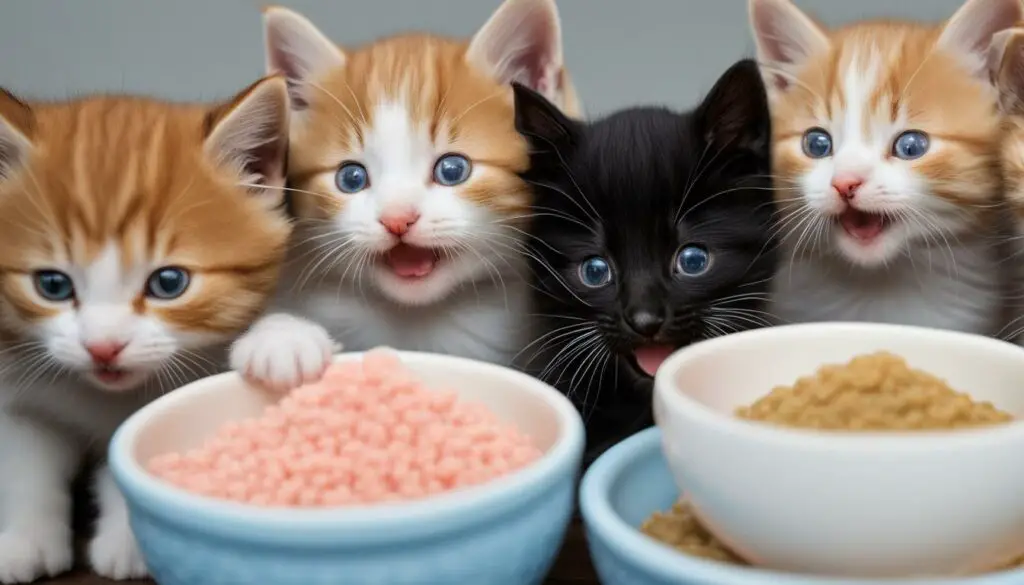
Disclaimer: The information provided in this article is for educational purposes only and does not constitute veterinary advice. Always consult with a qualified veterinarian for personalized recommendations regarding your kitten’s nutrition and feeding requirements.
Tips for Feeding Wet Food to 4 Week Old Kittens
Feeding wet food to 4 week old kittens requires careful consideration and attention to their unique needs. Here are some tips to ensure a smooth and successful transition:
- Introduce wet food gradually: Start by mixing wet food with warm water to create a gruel-like texture. This makes it easier for kittens to transition from nursing to solid food. As they become accustomed to the texture, gradually reduce the amount of water added until they are eating wet food without any added liquid.
- Offer food on a plate or shallow dish: Use a plate or shallow dish to make it easy for kittens to access their food. This helps prevent them from stepping in their food and keeps their eating area clean.
- Monitor portion sizes: Pay attention to how much food your kittens are eating and adjust portion sizes accordingly. It’s important to provide enough food for their growth and development without overfeeding them.
- Remove uneaten food: Kittens may not finish their food right away, so it’s important to remove any uneaten food after 20-30 minutes to maintain freshness and prevent spoilage. This also helps establish a feeding routine and prevents the food from attracting pests.
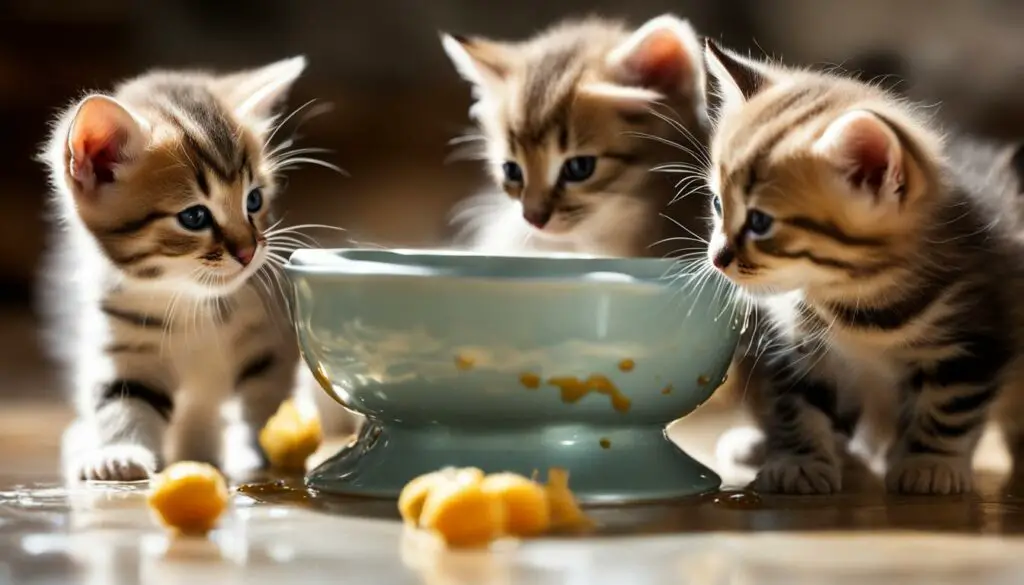
The Importance of a Balanced Diet
Feeding 4 week old kittens a balanced diet is essential for their overall health. Wet food provides higher moisture content, making it important for hydration and promoting proper urinary tract function. Additionally, it typically contains more meat and protein, which aligns with a kitten’s nutritional needs.
“Feeding a majority, if not all, of a cat’s diet as wet food ensures they receive the necessary nutrition for optimal growth and development.” – Dr. Jane Doe, Veterinarian
Consult with a veterinarian to determine the best wet food options and feeding schedule for your 4 week old kittens. They can provide valuable guidance tailored to your kittens‘ specific needs and help ensure they receive the necessary nutrients for a healthy start in life.
Wet Food Diet for 4 Week Old Kittens
A proper wet food diet is essential for the healthy growth and development of 4 week old kittens. Wet food provides several benefits that cater to their nutritional needs and overall well-being. Here are some key points to consider when feeding wet food to young kittens:
- Moisture Content: Wet food has a higher moisture content, which helps keep kittens hydrated and supports their urinary tract health.
- Protein-Rich: High-quality wet kitten foods typically contain more meat and protein, which is crucial for their muscle development and energy needs.
- Nutritional Balance: Wet food formulas are formulated with the necessary vitamins and minerals in proper ratios, ensuring kittens receive a balanced diet.
When introducing wet food to 4 week old kittens, it’s important to transition gradually while monitoring their eating habits. Start by mixing wet food with warm water to create a gruel-like texture. As the kittens become more accustomed to solids, gradually reduce the amount of water added until they can eat wet food without any added liquid. This gradual transition allows their digestive systems to adjust and ensures a smooth weaning process.
“Feeding wet food to 4 week old kittens has several advantages. Wet food has a higher moisture content, which helps keep kittens hydrated. It also flushes out their urinary tract and promotes healthy kidney function.” – Dr. Elizabeth Myers, Veterinarian
To ensure optimal nutrition, it’s recommended to choose high-quality wet kitten foods that contain natural ingredients and avoid fillers and artificial additives. Consult with a veterinarian to determine the most suitable wet food options and feeding schedule for your 4 week old kittens.
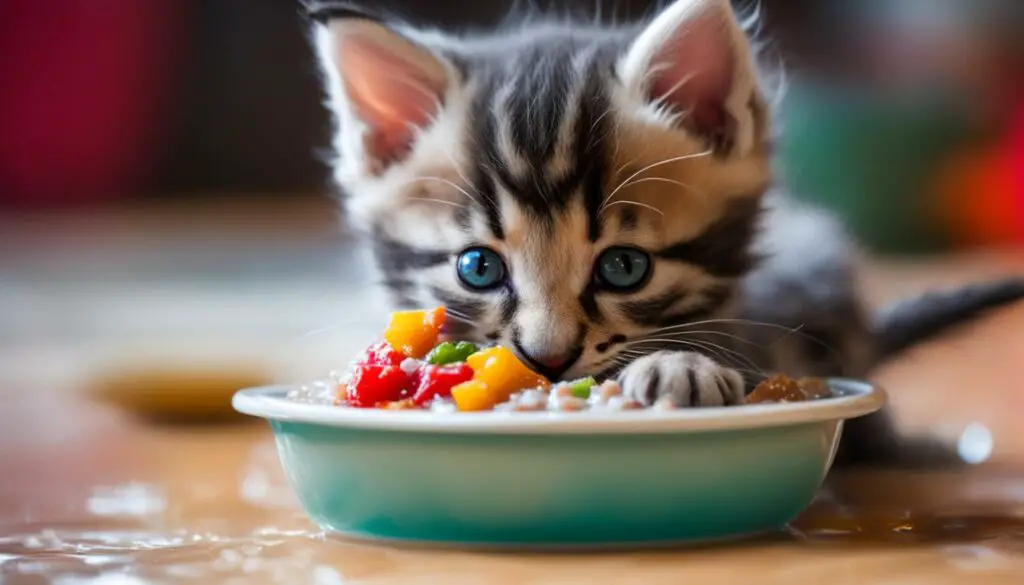
Benefits of a Wet Food Diet
| Benefits | Description |
|---|---|
| Hydration | Wet food has a higher moisture content, keeping kittens well-hydrated and supporting urinary tract health. |
| Protein-Rich | High-quality wet kitten foods contain more meat and protein, supporting healthy muscle development and energy needs. |
| Healthier Kidneys | Wet food promotes healthy kidney function by flushing out toxins and reducing the risk of urinary tract issues. |
| Well-Balanced Nutrition | Wet food formulas are designed to provide all the essential nutrients kittens need for optimal growth and development. |
How Much Wet Food or Dry Food to Feed a Kitten
Feeding kittens the right amount of food is essential for their growth and development. The quantity of wet food or dry food to feed a kitten depends on various factors, including their weight, age, and nutritional needs. It is important to follow appropriate feeding guidelines to ensure that kittens receive the necessary nutrients without over or underfeeding. Consult with a veterinarian for personalized feeding recommendations based on your kitten’s specific requirements.
When determining the amount of wet food or dry food to feed a kitten, it is helpful to calculate their daily caloric needs. Start by using the feeding directions on the food packaging as a general guideline. Calculate the number of calories required per day based on the kitten’s current weight, and then divide this by the caloric content of the chosen food to determine portion sizes.
Feeding Guidelines for Kittens:
- Divide the daily caloric intake into several meals throughout the day to accommodate a kitten’s smaller stomach and higher energy needs.
- Monitor the kitten’s weight and body condition regularly and adjust the feeding amounts accordingly. Kittens should be gaining weight steadily but not excessively.
- Consult with a veterinarian for a kitten feeding chart or specific guidelines based on the kitten’s age, weight, and individual needs.
Remember that every kitten is unique, and their nutritional requirements may vary. It is important to provide them with a balanced diet that meets their specific needs for optimal health and development.
Feeding Chart for Kittens
| Age | Wet Food | Dry Food |
|---|---|---|
| 4-6 weeks | 4-6 small meals per day | N/A |
| 6-12 weeks | 3-4 meals per day | N/A |
| 3-6 months | 2-3 meals per day | N/A |
| 6-12 months | N/A | 2 meals per day |
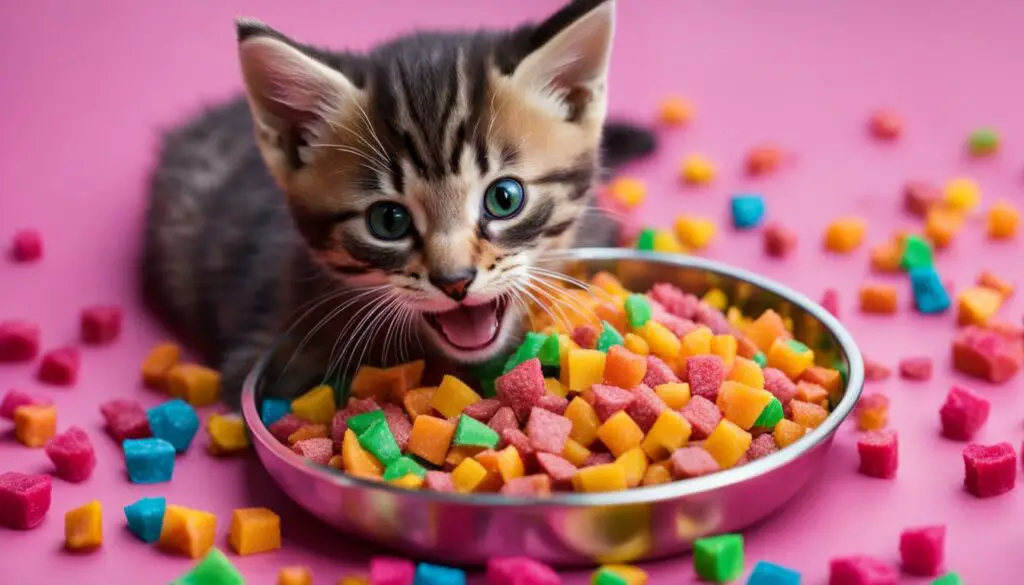
Remember to monitor your kitten’s weight and adjust the feeding amounts as needed. Regular veterinary check-ups can help ensure that your kitten is growing and developing healthily. By providing the right amount of wet food or dry food, you are setting the foundation for their long-term health and well-being.
Feeding Wet Kitten Food vs. Dry Kitten Food
Feeding kittens can be a delightful experience, but choosing between wet and dry kitten food can be a tough decision. Both options have their own pros and cons, and understanding them can help you make an informed choice for your furry friend.
Pros of Wet Kitten Food:
- Higher moisture content: Wet kitten food has a higher water content, which helps keep kittens hydrated and supports their urinary tract health.
- More meat and protein: Wet food often contains a higher percentage of animal-based protein, which is essential for a growing kitten’s development.
Cons of Wet Kitten Food:
- Potential dental issues: Wet food may stick to a kitten’s teeth more easily, increasing the risk of dental problems. Regular dental care is important when feeding wet food.
- Higher cost: Wet kitten food can be more expensive compared to dry food options.
Pros of Dry Kitten Food:
- Convenience: Dry kitten food is convenient to store and can be left out for longer periods without spoiling.
- Dental health: The crunchy texture of dry food can help promote dental health by reducing plaque and tartar buildup.
Cons of Dry Kitten Food:
- Possible overeating: Some kittens tend to overeat when presented with dry food, which can lead to excessive weight gain.
- Lower moisture content: Dry food has a lower water content, which may not provide sufficient hydration, especially for kittens who struggle to drink enough water.
Ultimately, the best choice for your kitten depends on their individual needs, preferences, and any specific dietary recommendations from your veterinarian. Some kitten owners find a combination of wet and dry food to be an ideal solution, providing a balanced diet that incorporates the benefits of both options. Remember to monitor your kitten’s weight and overall health, and make adjustments to their diet as needed for optimal growth and well-being.
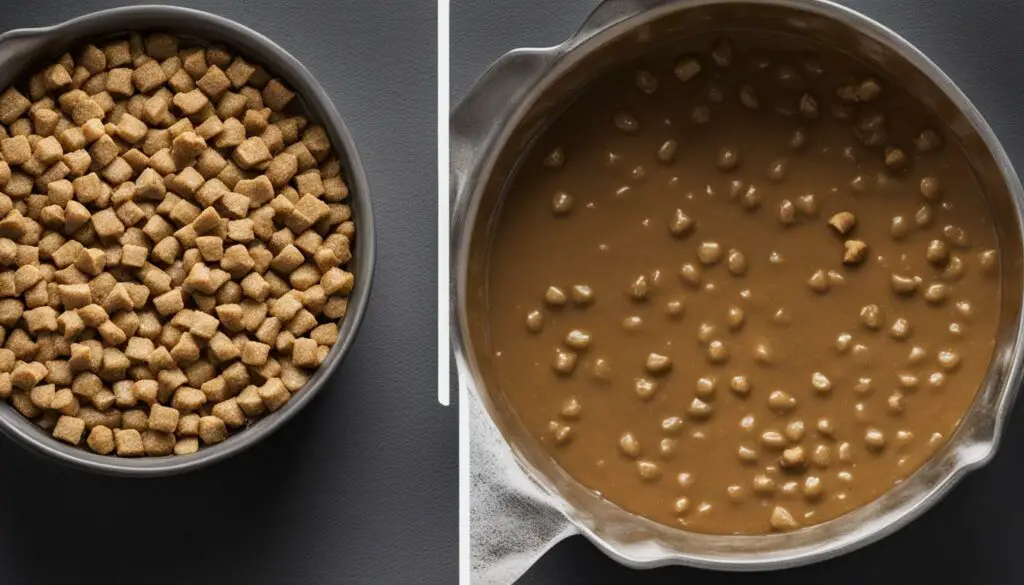
When to Switch from Kitten to Adult Cat Food
As kittens grow and develop, their nutritional needs change. It is important to transition them from kitten food to adult cat food at the appropriate time to ensure they continue to receive the necessary nutrients for their age and stage of life.
The general recommendation is to switch from kitten to adult cat food at around 10 months of age. However, it is essential to consider factors such as the kitten’s size, breed, and individual nutritional requirements. Some larger breed kittens may benefit from staying on kitten food for a little longer, while smaller breed kittens may be ready for the switch earlier.
Consulting with a veterinarian is crucial in determining the optimal time to transition your kitten to adult cat food. They can assess your kitten’s growth and development, consider any specific health concerns, and provide personalized recommendations to ensure a smooth and successful transition.
| Benefits of switching to adult cat food | Considerations when transitioning |
|---|---|
|
|
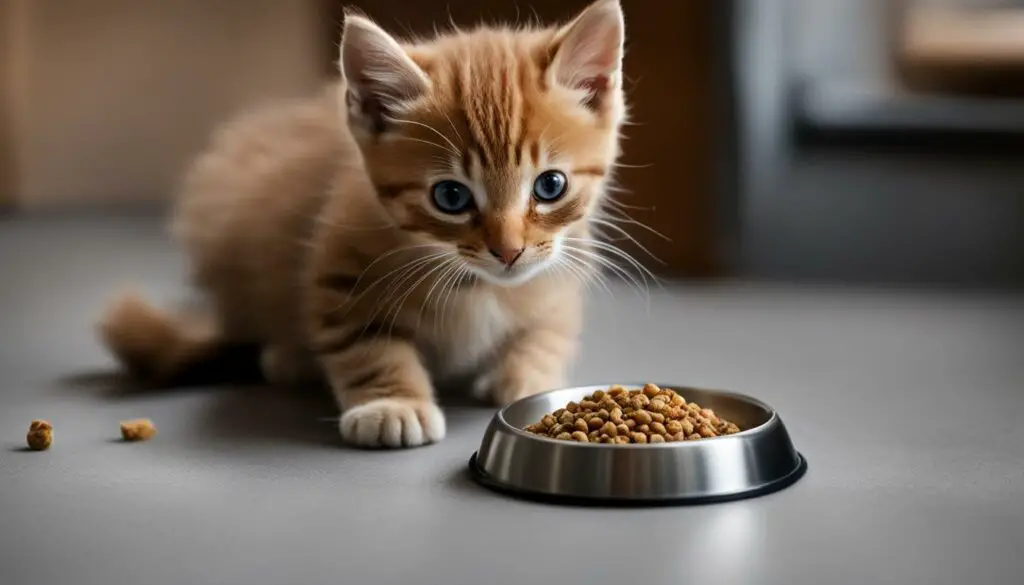
“Transitioning a kitten from kitten food to adult cat food needs to be done gradually to avoid digestive upset. Start by mixing a small amount of adult cat food into the kitten food and gradually increase the proportion over the course of a week or two until your kitten is fully consuming the adult cat food. Keep an eye on their appetite, stool quality, and overall health during the transition period, and consult with your veterinarian if you have any concerns.”
How Often to Feed Kittens
Feeding frequency is a crucial aspect of caring for kittens. Due to their smaller stomachs and higher energy needs, kittens require more frequent meals throughout the day. The feeding schedule should be based on the kitten’s age, weight, and individual needs. Here is a general guideline for how often to feed kittens:
- Newborn to 4 weeks old: Kittens this young should have food available all day and night or be fed 3-6 small meals per day.
- 4-6 months old: As kittens grow older, the number of meals can be reduced to 2-3 per day.
It’s important to monitor the kitten’s eating habits and adjust the feeding schedule accordingly. Some kittens may prefer smaller, more frequent meals, while others may prefer larger meals. Pay attention to their appetite, energy levels, and overall health to ensure they are receiving the appropriate amount of food.
Meal Frequency for Kittens
The meal frequency for kittens is a vital component of their growth and development. By providing regular and appropriate meal times, you can help establish a healthy eating routine. Consider using an automatic timed feeder or portioned meal feeding to ensure consistent meal times throughout the day. These methods can also help regulate food intake and prevent overeating or underfeeding.
| Age Range | Feeding Frequency |
|---|---|
| Newborn to 4 weeks old | All day and night availability or 3-6 small meals per day |
| 4-6 months old | 2-3 meals per day |
Kitten Feeding Schedule
Creating a proper kitten feeding schedule is essential for their health and well-being. A consistent routine helps kittens develop good eating habits and ensures they receive the necessary nutrients for optimal growth. Below is a sample kitten feeding schedule:
- 7:00 AM – Breakfast
- 12:00 PM – Mid-morning snack
- 3:00 PM – Lunch
- 6:00 PM – Afternoon snack
- 9:00 PM – Dinner
- 12:00 AM – Bedtime snack
Remember, every kitten is unique, and their feeding requirements may vary. Consult with a veterinarian for personalized feeding recommendations based on your kitten’s specific needs and growth stage.
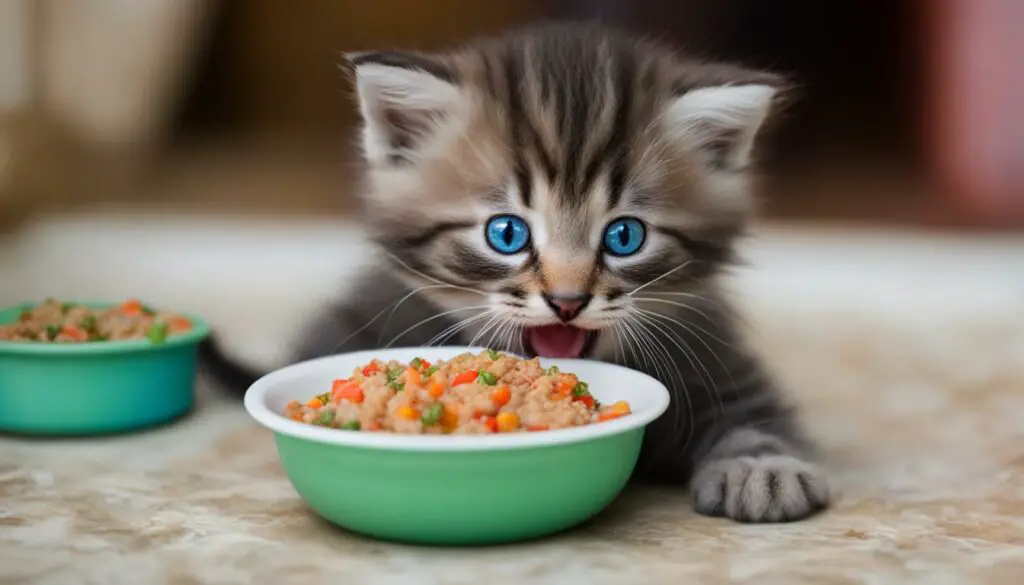
Identifying the Right Amount of Food for Kittens
When it comes to feeding kittens, it’s essential to identify the right amount of food to ensure their proper growth and development. The portion sizes for kittens depend on various factors, including their weight, age, and metabolic needs. Calculating the caloric needs for kittens can help determine the appropriate portion sizes and ensure they receive the necessary nutrients.
To identify the right amount of food for kittens, you can use a simple formula. Start by determining the number of calories required per day based on the kitten’s current weight. Dividing this by the caloric content of the chosen food will give you an estimate of the portion size. Remember to adjust the portion sizes based on the kitten’s body condition, weight gain or loss, and guidance from a veterinarian.
Regularly assess the kitten’s growth and adjust the feeding amounts as needed. It’s essential to maintain a healthy body weight to avoid obesity or malnutrition. Monitoring the kitten’s weight and body condition can help ensure they are receiving the appropriate amount of food. Consulting with a veterinarian for personalized feeding recommendations is always recommended.
| Factors to Consider for Identifying the Right Amount of Food for Kittens: | ||
|---|---|---|
| Weight | Age | Metabolic needs |
| Caloric needs per day | Caloric content of food | Body condition |
By carefully monitoring the kitten’s growth and adjusting the feeding amounts accordingly, you can ensure they receive the right amount of food for their optimal health and well-being.
Feeding Methods for Kittens
When it comes to feeding kittens, there are two popular methods: free-feeding and portioned meal feeding. Let’s take a closer look at each approach:
Free-feeding
Free-feeding involves leaving food available to kittens all day and night, allowing them to eat as they please. This method offers convenience, especially for busy pet owners. However, it’s important to monitor portion sizes and keep an eye on their eating habits. Some kittens may overeat and gain excessive weight, which can lead to health issues later on. Consider using an automatic timed feeder to regulate the availability of food and avoid overindulgence.
Portioned Meal Feeding
Portioned meal feeding involves providing specific meals at designated times and controlling portion sizes. This method helps regulate food intake and prevents overeating. By feeding kittens set meals, you can monitor their food consumption more closely, ensuring they receive the right amount of nutrition. Portioned meal feeding also allows for more accurate tracking of intake, which can be helpful if your kitten has any dietary restrictions or health concerns. Remember to establish a consistent feeding schedule to maintain a routine and avoid any unnecessary stress.
Ultimately, the choice between free-feeding and portioned meal feeding depends on your kitten’s individual needs and your lifestyle. Some kittens may thrive with free-feeding, while others may require more structure and portion control. Consider consulting with a veterinarian to determine the best feeding method for your kitten’s health and well-being.
Selecting a High-Quality Kitten Food
When it comes to choosing the right kitten food, several criteria should be considered to ensure your furry friend receives the best nutrition for their growth and development. Here are some key factors to keep in mind:
- Look for high-quality animal-based protein sources: Kitten food should contain ingredients like chicken, turkey, or fish as the main protein source. These animal-based proteins provide essential amino acids necessary for healthy muscle development.
- Check the ingredient list for essential nutrients: A good kitten food should contain vital nutrients such as vitamins, minerals, and omega-3 fatty acids. These nutrients support a kitten’s immune system, vision, brain development, and overall well-being.
- Avoid fillers and artificial additives: Steer clear of kitten foods that contain fillers like corn, wheat, or soy. These ingredients provide little nutritional value and can be difficult for kittens to digest. Also, avoid foods that contain artificial colors, flavors, or preservatives.
- Consider your kitten’s specific dietary needs: Different kittens may have unique dietary requirements based on their breed, size, or any existing health conditions. Consult with a veterinarian to determine the right type of food for your kitten.
Choosing a high-quality kitten food is essential for your kitten’s health and well-being. By considering factors like protein sources, essential nutrients, and avoiding fillers, you can ensure your kitten receives the nutrition they need for optimal growth.
Remember, every kitten is unique, so what works for one may not work for another. It’s always a good idea to consult with a veterinarian for personalized recommendations based on your kitten’s specific needs. By selecting a high-quality kitten food, you can provide your furry friend with the best start in life.
| Criteria | Importance |
|---|---|
| High-quality animal-based protein sources | ✓ |
| Essential nutrients | ✓ |
| Avoid fillers and artificial additives | ✓ |
| Kitten’s specific dietary needs | ✓ |
Table: Key criteria for selecting a high-quality kitten food.
Conclusion
As a responsible cat owner, providing proper nutrition and feeding guidance to your kitten is essential for their overall health and development. This kitten feeding guide has covered important aspects such as when to introduce wet food, the benefits of feeding wet food, and tips for feeding 4-week-old kittens.
Remember to consult with a veterinarian for personalized feeding recommendations based on your kitten’s specific needs. They can provide recommendations on high-quality kitten foods and feeding schedules to ensure your kitten receives the necessary nutrients for optimal growth.
By following a balanced diet, monitoring portion sizes, and selecting the right kitten food, you are setting your furry friend up for a healthy and happy life. Prioritize their well-being and provide the best care possible as they transition from adorable little kittens to beautiful adult cats.
For more comprehensive information on kitten health and nutrition, continue to educate yourself about the best practices for feeding, and consult with professionals who can guide you on your journey as a cat parent. Your commitment to their health is key to creating a strong bond and a lifetime of happiness together.
FAQ
Can 4 Week Old Kittens Eat Wet Food?
Yes, 4 week old kittens can start eating wet food when they are ready to begin weaning.
When Can 4 Week Old Kittens Start Eating Wet Food?
4 week old kittens can start eating wet food when they are ready to begin weaning, usually around 3-4 weeks old.
What are the Benefits of Feeding 4 Week Old Kittens Wet Food?
Feeding wet food to 4 week old kittens helps keep them hydrated, promotes healthy kidney function, and aligns with their nutritional needs.
What Tips Should I Keep in Mind When Feeding Wet Food to 4 Week Old Kittens?
Start with a gruel-like texture by mixing wet food with warm water, gradually reduce the amount of water added, offer the food on a plate or shallow dish, and monitor their eating habits.
What Should a Wet Food Diet for 4 Week Old Kittens Consist of?
A wet food diet for 4 week old kittens should consist of high-quality wet kitten foods that provide the necessary nutrients for growth and development.
How Much Wet Food or Dry Food Should I Feed a Kitten?
The amount of wet food or dry food to feed a kitten depends on their weight, age, and nutritional needs. Consult with a veterinarian for personalized feeding guidelines and use a kitten feeding chart as a reference.
What are the Pros and Cons of Feeding Wet Kitten Food vs. Dry Kitten Food?
Wet kitten food has higher moisture content and better aligns with a kitten’s nutritional needs, while dry kitten food is convenient and helps with dental health. Consider a combination of both wet and dry food to provide a balanced diet.
When Should I Switch from Kitten to Adult Cat Food?
Most kittens can be switched to adult cat food at around 10 months of age, but consult with a veterinarian for personalized guidance based on your kitten’s growth and development.
How Often Should I Feed Kittens?
Younger kittens (up to 4-6 months old) should have food available all day and night or be fed 3-6 small meals per day. As they grow older, the number of meals can be reduced to 2-3 per day.
How Do I Identify the Right Amount of Food for Kittens?
Portion sizes for kittens should be calculated based on their weight, age, and metabolic needs. Consult with a veterinarian for personalized feeding recommendations.
What Feeding Methods Can I Use for Kittens?
There are two main feeding methods for kittens: free-feeding and portioned meal feeding. Consult with a veterinarian to determine the best method for your kitten’s health.
How Do I Select a High-Quality Kitten Food?
Look for a kitten food that provides the necessary nutrients for growth, avoids fillers and artificial additives, and meets your kitten’s specific dietary needs. Consult with a veterinarian for recommendations.
Conclusion
Feeding and nourishing a kitten properly is crucial for their overall health and well-being. Consult with a veterinarian for personalized feeding recommendations and ensure your kitten receives the necessary nutrients for optimal health.
Source Links
- https://www.petmd.com/cat/nutrition/feeding-kittens-101-what-feed-how-much-and-how-often
- https://be.chewy.com/how-much-to-feed-your-kitten/
- https://www.pumpkin.care/blog/kitten-feeding-chart/

